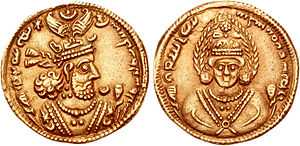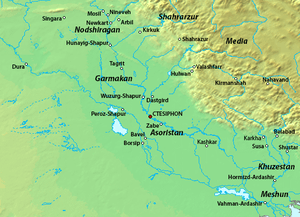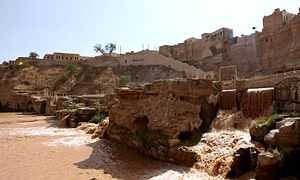Hormuzan
| Hormuzan | |
|---|---|
| Born | Mihragan-kadag, Media, Iran |
| Died |
644 Medina, Arabia |
| Allegiance |
|
| Service/branch | Sasanian army |
| Rank | Shahrdar (governor) |
Hormuzan (Middle Persian: Hormazdān, New Persian: هرمزان) was a Iranian aristocrat, who served as the governor of Khuzestan, and was one of the Sasanian military officers at the Battle of al-Qādisiyyah. He was later taken as prisoner by the Muslims after the fall of Shushtar in 642.
Family and early life

Hormuzan was a wealthy aristocrat native to Mihragan-kadag, a district in Media.[1] He was from one of the seven Parthian clans of the Sasanian Empire and was the brother-in-law of Khosrau II (r. 590-628) and the maternal uncle of Kavadh II (r. 628).[2] However, this is most likely wrong since Kavadh's mother was a Byzantine princess named Maria.[3] According to Pourshariati, Hormuzan may have belonged to a Persian family instead of a Parthian one.[3] Although his origin is disputed, it is known that he was part of the Parsig (Persian) faction which played a major role in Sasanian politics and is first mentioned in 628. Hormuzan owned his native place Mihragan-kadag as a part of his family domain, including all of Khuzestan,[2] one of the richest provinces of the Sasanian Empire.
Hormuzan is first mentioned in 609, as one of the Sasanian officers at the Battle of Dhi Qar, a battle between the Sasanians and rebellious Arabs; the Arabs managed to defeat the Sasanians, but order was soon restored by a certain Ruzbi, the governor (marzban) of al-Hira.[4] In 628, Khosrau II was overthrown by his son Kavadh II, who crowned himself as shahanshah (king of kings) of the Sasanian Empire. Three days later, Kavadh ordered Mihr Hormozd to execute his father. In 632, after a period of coups and revolts, Yazdegerd III (r. 632-651) was crowned as king of the Sasanian Empire at Estakhr, an ancient Iranian city in Pars, where the Sasanian family laid foundation to the their empire.
The Arab invasion of western Persia

In 633, the Muslim Arabs invaded Persia, and by 636, they were camping at al-Qadisiyyah, a city close to Ctesiphon, the capital of the Sasanian Empire.
The Sasanian army chief (spahbed), Rostam Farrokhzad, then prepared a counter-attack, and raised an army which included: The Parsig faction under Piruz Khosrow, Bahman Jadhuyih and Hormuzan. The Pahlav (Parthian) faction under Rostam himself and Mihran Razi, and a Armenian contingent under Jalinus and Musel III Mamikonian. The army also included the military officer Kanadbak and his son, known in Arabic sources as Shahriyar bin Kanara.[5] During the battle, the Sasanian army was defeated, and Shahriyar, along with Musel, Bahman, Jalinus and Rostam, were killed. The Arabs then besieged Ctesiphon.
Hormuzan managed to survive and along with Nakhiragan, Mihran Razi and Piruz Khosrow, including the rest of the survivors, regrouped at Bavel (Babylon), where they tried to repel the Arab army, but were once again defeated.[6] Hormuzan then fled to Hormizd-Ardashir in Khuzestan, which he used as his base in his raids in Meshan against the Arabs.[4] Yazdegerd III supported him in these raids, and believed that it was possible to regain the territories which had been taken by the Arabs.[7] Hormuzan, along with the rest of the survivors of al-Qadisiyyah, later regrouped again and fought the Arabs at the battle of Jalula in 637. The Sasanian army was once again defeated and Mihran Razi was killed. Hormuzan then again withdrew to Hormizd-Ardashir and this time chose to stay there in case the Arabs should invade his domains.
Hormuzan then continued his raids into Meshan and also began raiding in Iraq. He then repelled the Kurds (a term then used to describe Iranian nomads) who had been making incursions Fars and Khuzestan. Hormuzan shortly clashed with an Arab army to the west of Hormizd-Ardashir, but was easily defeated and retreated back to the city, where he asked for peace. The Arabs agreed in exchange for tribute, which Hormuzan agreed to.[8] However, he soon stopped paying tribute, and raised an army which included the Kurds he previously had fought.[8] The caliph (ruler) of the Rashidun Arabs, responded by sending an army under a certain Hurqus ibn Zuhayr al-Sa'di, who defeated Hormuzan in 638 at Hormizd-Ardashir, and forced the city to pay jizya (poll-tax).[9] Meanwhile, Hormuzan fled to Ram-Hormizd. Hormuzan once again sought a peace treaty and was granted one in return for tribute.[9]

When he stopped paying paying tribute, he was once again defeated, while the cities of Khuzestan were slowly one by one seized. Sometime later in 641, after a defeat at Ram-Hormizd, Hormuzan fled to Shushtar, and was defeated near the city, which cost him the lives of 900 of his men, while 600 were captured and would later be executed. Nevertheless, he managed to reach the city.[10] The Arabs then laid siege to the city.
Fortunately for Hormuzan, Shushtar was well fortified due to the rivers and canals that surrounded it on almost all sides.[11] There are several versions of the how the city got captured; according to al-Tabari, during the siege, an Iranian defector named Sina (or Sinah) went to al-Nu'man and pleaded for his life to be spared in return for helping him how to show a way into the city. Al-Nu'man agreed, and Sina told him the following thing; "attack via the outlet of the water, and then you will conquer the city."[12]
Al-Nu'man did as he told him, and with a small portion of his army, charged into Shushtar. Hormuzan then retreated to the citadel and continued his resistance. The surviving men of Hormuzan who were in citadel along with him, killed their own family members and threw their property into the river rather than let the Arabs take them.[13] In the end, Hormuzan was eventually forced to surrender.[13][12]
According to another version written in the Khuzestan Chronicle, similar to the version by al-Tabari, a defector from Qatar, along with another person, asked the Arabs for some of their plunder in exchange for how to enter the city. The Arabs agreed, and after some time, they managed to enter the city.[11] According to al-Baladhuri, during the siege, the Arabs were reinforced with a group of professional Iranian elites under Siyah al-Uswari, known as the Asawira.[14] The reason for their defection was in order to preserve their status and wealth. However, according to the Khuzestan Chronicle, the Asawira first defected to the Arabs after they entered Shushtar. The brother of Hormuzan, Shahriyar, is said to have been a part of the Asawira.[14] According to Pourshariati, the story of the Asawira helping the Arabs in their conquest of Khuzestan, may have been false.[1] Nevertheless, it is known that Hormuzan was after his surrender taken by the Arabs and brought to their capital Medina.
Captivity and death
What happened after is told by George Rawlinson, in summary, as follows:[15]
| “ | Hormuzan, on obtaining an audience, pretended thirst and asked for a cup of water, which was given him; he then looked suspiciously around, as if he expected to be stabbed while drinking. "Fear nothing," said Umar; "your life is safe till you have drunk the water." The crafty Persian flung the cup to the ground, and Umar felt that he had been outwitted, but that he must keep his word. | ” |
Hormuzan was then given a pension, but initially refused to convert to Islam in some time. He only converted after being told that he should choose between death and Islam.[16][17] While in Medina, he advised the Rashidun Caliph Umar in making important fiscal and institutional changes. However, in 644, Hormuzan was killed by Umar's son 'Ubaid-Allah, after an involvement in a plot which killed Umar.[13] The new Rashidun Caliph, Uthman, instead of punishing 'Ubaid-Allah for his actions, instead had him pardoned. This was not well received by some of Hormuzan's Arab supporters, such as Muhammad's cousin Ali, who strongly protested to Uthman[18] and even later tried to take action against 'Ubaid-Allah, who managed to flee to the challenger of Rashidun rule, Muawiyah I.[2]
References
- ↑ 1.0 1.1 Pourshariati 2008, p. 240.
- ↑ 2.0 2.1 2.2 Shahbazi 2004, pp. 460–461.
- ↑ 3.0 3.1 Pourshariati 2008, p. 236.
- ↑ 4.0 4.1 Morony 2005, p. 193.
- ↑ Pourshariati 2008, pp. 232-233, 269.
- ↑ Morony 2005, p. 192.
- ↑ Zarrinkub 1975, p. 14.
- ↑ 8.0 8.1 Jalalipour 2014, p. 6.
- ↑ 9.0 9.1 Jalalipour 2014, p. 7.
- ↑ Jalalipour 2014, p. 9.
- ↑ 11.0 11.1 Jalalipour 2014, p. 10.
- ↑ 12.0 12.1 Jalalipour 2014, p. 8.
- ↑ 13.0 13.1 13.2 Zarrinkub 1975, p. 15.
- ↑ 14.0 14.1 Jalalipour 2014, pp. 12-13.
- ↑ Rawlinson 2004.
- ↑ Pourshariati 2008, p. 238.
- ↑ Muir 2004, p. 176.
- ↑ Madelung 1998, p. 69.
Sources
- Shahbazi, A. Shapur. (2004). "HORMOZĀN". Encyclopaedia Iranica, Vol. I, Fasc. 5. p. 460–461.
- Pourshariati, Parvaneh (2008). Decline and Fall of the Sasanian Empire: The Sasanian-Parthian Confederacy and the Arab Conquest of Iran. London and New York: I.B. Tauris. ISBN 978-1-84511-645-3.
- Zarrinkub, Abd al-Husain (1975). "The Arab conquest of Iran and its aftermath". The Cambridge History of Iran, Volume 4: From the Arab Invasion to the Saljuqs. Cambridge: Cambridge University Press. pp. 1–57. ISBN 978-0-521-20093-6.
- Morony, Michael G. (2005) [1984]. Iraq After The Muslim Conquest. Gorgias Press LLC. ISBN 978-1-59333-315-7.
- Jalalipour, Saeid (2014). The Arab Conquest of Persia: The Khūzistān Province before and after the Muslims Triumph (PDF). Sasanika.
- Rawlinson, George (2004). The Seven Great Monarchies of the Ancient Eastern World, Vol 7. (of 7): The Sassanian the History, Geography and Antiquities of Chaldaea, Assyria, Babylon, Media, Persia, Parthia and Sassanian or New Persian Empire. Library of Alexandria. ISBN 1465506721.
- Madelung, Wilferd (1998). The Succession to Muhammad: A Study of the Early Caliphate. London and New York: Cambridge University Press. ISBN 0521646960.
- Muir, Sir William (2004). The Caliphate: Its Rise, Decline, and Fall from Original Sources. London and New York: Kessinger Publishing. ISBN 1417948892.